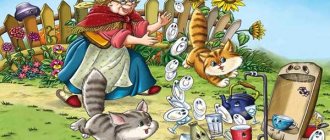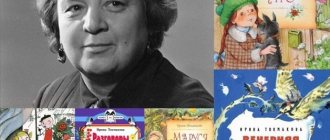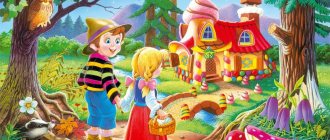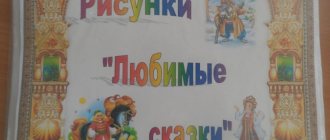Literary quiz with answers on Pushkin's fairy tales for primary school students
Quiz on fairy tales by A.S. Pushkin for schoolchildren in grades 1-4 with answers
Author: Natalia Aleksandrovna Klyuka, teacher of additional education for children, Ecological and Biological Center, Dzerzhinsk, Nizhny Novgorod region. Features of Pushkin's fairy tales are a dynamic plot, unusual situations and events full of miracles and luxury. And since every detail in them is natural, closely related to life or taken from the world surrounding the child, it is very easy to read and understand them. Many heroes of Pushkin's fairy tales behave like people from a working, peasant environment. They do not shy away from simple physical labor: lighting the stove, cleaning the house, thereby helping to instill in children respect for work. Pushkin's fairy tales are written in verse, but children always perceive them with a bang, since they are presented in simple and understandable language. Each fairy tale contains aphorisms and an accessible explanation of what conclusion the child should draw after reading. And, most importantly, absolutely all of Pushkin’s fairy tales foster noble feelings. I offer a literary quiz based on the fairy tales of A.S. Pushkin, addressed to primary school students. The material may be useful to parents, primary school teachers, teacher-organizers when preparing and conducting extracurricular hours, literary festivals, Family Day, as well as teachers of summer camp shifts. Goal: Activating children's knowledge about the fairy tales of the great Russian poet A.S. Pushkin. Objectives: Educational.
Expand children's knowledge about the fairy tales of A.S. Pushkin. Continue to teach children to extract wisdom from the fairy tales they read. Developmental. Develop thinking, memory, the ability to quote lines from literary works, the ability to concentrate to find an answer. Educational. To cultivate an interest in reading and a sense of pride in the great Russian poet A.S. Pushkin. Quiz questions:
1. Which fairy tale is not written by A.S. Pushkin: a) “The Tale of the Fisherman and the Fish” b) “The Little Humpbacked Horse” c) “The Tale of the Priest and His Worker Balda” d) “The Tale of the Golden Cockerel” (“The Little Humpbacked Horse”, its author Pyotr Ershov) 2. What words does “The Tale of the Fisherman and the Fish” begin with? “An old man lived with his old woman by the very blue sea...”
3. In “The Tale of Tsar Saltan,” what kind of future did each of the sisters see for themselves if they were a queen? (the first – “Then I would prepare a feast for the whole baptized world...”, the second – “Then I would weave linens for the whole world alone...”, the third – “I would give birth to a hero for the father-king...”)
4. What was the name of the king in “The Tale of the Golden Cockerel”? (King Dadon) 5. In which fairy tale by A.S. Pushkin does the Shamakhan queen “live”? (“The Tale of the Golden Cockerel”) 6. In “The Tale of the Priest and His Worker Balda,” what kind of workers was the priest looking for at the market? (groom, cook and carpenter) 7. How many years did the old man live with his old woman in “The Tale of the Fisherman and the Fish”? (33 years old) “They lived in a dilapidated dugout for exactly thirty years and three years” 8. What words did the queen address to the mirror in “The Tale of the Dead Princess and the Seven Knights”? “My light, mirror! Tell me, tell me the whole truth: Am I the sweetest in the world, the most ruddy and whitest of all?..”
9. How was the golden cockerel useful to King Dadon? (indicated from which side there is a threat of attack on the king’s possessions)
10. From which tree branch did Prince Guidon make himself a bow? (from an oak branch) “Mother and son are now free; They see a hill in a wide field, a blue sea all around, a green oak tree above the hill. The son thought: we would, however, need a good dinner. He breaks the oak branch and bends the bow tightly...” 11. In “The Tale of the Dead Princess and the Seven Knights,” why do you think the hay girl was called Chernavka? (She was a maid, did “menial” work around the house) 12. How did the old woman scold the old man in “The Tale of the Fisherman and the Fish”? “You fool, you simpleton! You didn’t know how to take ransom from a fish!” 13. What insects did the Swan Princess turn Prince Guidon into? (into a mosquito, a fly, a bumblebee) 14. In “The Tale of the Dead Princess and the Seven Knights,” what was the name of the dead princess’s groom? (Elisha) “But the young princess, quietly blossoming, meanwhile grew and grew, rose and blossomed. White-faced, black-browed, such a meek disposition. And a groom was found for her, Prince Elisha..."
15. Name the optical device with which Prince Guidon viewed ships approaching the island? (spyglass) 16. In “The Tale of the Golden Cockerel,” what the cockerel crowed while sitting on a knitting needle” (“Kiri-ku-ku, reign while lying on your side!”) 17. In “The Tale of Tsar Saltan,” what three Were there any miracles on Buyan Island? (squirrel, 33 heroes, princess Swan) “The spruce tree grows in front of the palace, And under it is a crystal house;
The tame squirrel lives there, what an adventure! The squirrel sings songs and gnaws everything on nuts, but the nuts are not simple, all the shells are golden, the kernels are pure emerald; The servants are guarding the squirrel..."
* “The sea will swell violently, It will boil, it will howl, It will rush onto the empty shore, It will spill in a noisy run, And they will find themselves on the shore, In scales like the heat of grief, Thirty-three heroes...”
* “And the prince has a wife, That you can’t take your eyes off: During the day the light of God is eclipsed, At night it illuminates the earth; The moon shines under the scythe, And in the forehead the star burns..."
18. What were these products made from golden shells that were used around the world? (gold coins) 19. What wishes did the old woman have in “The Tale of the Fisherman and the Fish”? - a new trough - a new hut - to be a pillar noblewoman - to be a free queen - to be the mistress of the sea 20. Who gave King Dadon a golden cockerel? (stargazer sage)
21. In “The Tale of the Fisherman and the Fish,” what kind of fur was the old woman wearing when she became a noblewoman? (From sable fur) “The old man returned to the old woman. What does he see? High tower. His old woman is standing on the porch in an expensive sable jacket...") 22. Who turned the head of King Dadon in “The Tale of the Golden Cockerel”? (Shamakhan Queen)
23. Who did King Elisha turn to in search of his bride, and who told him where to look for her? (to the sun, moon and wind; prompted by the wind) 24. Giving his butt a click, what did Balda say reproachfully? (“Don’t you, priest, chase after cheap things”)
25. Why in “The Tale of the Fisherman and the Fish” by A.S. Did Pushkin leave the old woman at a broken trough? (for excessive greed)
******************************************************************************
“The fairy tale is a lie, but there is a hint in it!
A lesson to good fellows." (A.S. Pushkin) Brief biographical information. The great Russian poet and writer Alexander Sergeevich Pushkin was born in Moscow on June 6, 1799. From early childhood, Pushkin grew up and was brought up in a literary environment, so we can say with confidence that his future was predetermined. Alexander Sergeevich’s father was a connoisseur of literature, had a large library, his uncle was a famous poet, who was often visited by many famous literary figures of that time. His nanny, Arina Rodionovna, had a huge influence on the future poet, whom the poet will remember throughout his life and devote many literary works to her. In 1811, his father and uncle decide to send 12-year-old Pushkin to the newly opened Tsarskoye Selo Lyceum. The role of the Lyceum in the development of Pushkin’s personality is difficult to overestimate; it was there that he began to write his first poems, met and became friends with such famous people in the future as Ivan Pushchin, Wilhelm Kuchelbecker, Anton Delvig and many others, whose friendship would last his entire life. In 1814, the first poem of the then fifteen-year-old Pushkin, “To a Friend the Poet,” was published. After graduating from the Lyceum in 1817, Pushkin did not return to Moscow, but moved to St. Petersburg, where he joined the College of Foreign Affairs. And after three years, Pushkin completed his famous poem “Ruslan and Lyudmila”. In 1830, Pushkin wooed, and in 1831 he married Natalya Goncharova. Before his marriage, he went to an estate in Boldino, where he was forced to stay due to quarantine. This period in Pushkin’s work is called the Boldin Autumn, during which he wrote a large number of literary works of various genres. On February 9, 1837, Pushkin fought a duel with Dantes, was mortally wounded and died on February 10 in his house on the Moika. He was 37 years old.
************************************************************************
We recommend watching:
Literary quiz for elementary school with answers “How to be able to read well” Literary quiz with answers for schoolchildren in grades 3-6 “Your own game” Literary quiz for elementary school with answers Literary quiz with answers for students in grades 8 – 11
Similar articles:
Literary quiz for grades 1-4 on fairy tales
Game "Tic Tac Toe" based on the fairy tales of A.S. Pushkin for 3 - 4 grades
Literary game based on Andersen's fairy tales for grade 3
Literary living room in an elementary school. Pushkin
Game script – quizzes based on Pushkin’s fairy tales for older preschoolers
Quiz room
Design of the event “Quiz on Pushkin’s fairy tales” includes:
an exhibition of children's works on the theme "Pushkin's Fairy Tales", illustrations and quotes from Pushkin's fairy tales on the walls. A selection of literature on the topic, which can be designed in the form of a poet’s desk with an inkwell and a quill pen.
Melodies from musical works on a Pushkin theme are heard in the room. Before the start of the quiz on Pushkin's fairy tales, you can include excerpts of poems in audio recordings.
Task No. 4
You need to recognize the heroes from fairy tales from their descriptions.
1. She was more beautiful than her stepmother and therefore almost died.
2. He grew up in a barrel and became a prince.
3. He caught a magic fish.
4. She was a pillar noblewoman, a queen, but she was left with nothing.
5. A rooster pecked him on the crown.
6. He outsmarted the devils.
7. She married the king and bore him a son.
8. She cooked well.
9. She knew how to weave linen.
10. She had strong teeth and could bite through golden shells.
Task No. 2
Children are given tasks.
Name (write in your notebook) the fairy tales based on which the picture was drawn.
Oral drawing: describe the Pushkin hero you liked according to the following plan:
- What fairy tale character is he?
- What does it look like?
- What is his character?
- What good deeds does he do in the fairy tale?
Who are the negative characters? (Those who do bad things).
Name (write down) the characters in Pushkin’s fairy tales that you consider bad.








